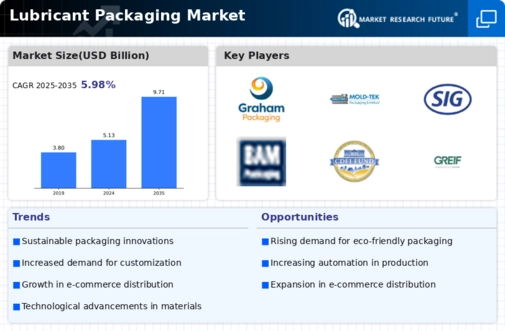Top Industry Leaders in the Lubricant Packaging Market
 The lubricant packaging market, a crucial cog in the global automotive and industrial machinery sector, is a surprisingly fluid and competitive space. fueled by factors like rising demand for electric vehicles, increased focus on sustainability, and advancements in packaging technologies. This dynamic landscape sees established giants like Scholle IPN and Berry Global jostling with innovative startups and regional players, all vying for a larger share of the oily pie.
The lubricant packaging market, a crucial cog in the global automotive and industrial machinery sector, is a surprisingly fluid and competitive space. fueled by factors like rising demand for electric vehicles, increased focus on sustainability, and advancements in packaging technologies. This dynamic landscape sees established giants like Scholle IPN and Berry Global jostling with innovative startups and regional players, all vying for a larger share of the oily pie.
Strategies Adopted by Key Players:
-
Product Diversification: Offering a diverse range of containers for different lubricant types (engine oil, hydraulic fluids, greases) and volumes (bulk, individual bottles, cartridges) caters to diverse customer needs. AptarGroup's portfolio and Greif, Inc.'s focus on custom solutions exemplify this approach. -
Embracing Innovation: R&D leads to cutting-edge solutions. Amcor Limited's development of lightweight, tamper-proof containers and Sonoco Products Company's focus on smart packaging with integrated sensors showcase this emphasis on innovation. -
Strategic Partnerships and Acquisitions: Collaborations accelerate development and expand reach. BWAY Corporation's partnership with Eastman Chemical Company for recyclable materials and Sealed Air Corporation's acquisition of Greif, Inc.'s rigid container business exemplify this strategy. -
Focus on Sustainability: Eco-friendly materials like bioplastics and recycled content, along with reduced packaging waste initiatives, resonate with environmentally conscious consumers and businesses. Scholle IPN's use of post-consumer recycled content and Berry Global's focus on closed-loop recycling programs showcase this trend. -
Digitalization and Customer Service: Implementing e-commerce platforms, real-time inventory tracking, and customized packaging solutions enhance service and build stronger relationships with industrial manufacturers. AptarGroup's online ordering platform and Justrite Manufacturing Company's technical support services exemplify this focus.
Factors Influencing Market Share:
-
Technological Advancements: Advancements in materials like barrier films and dispensing technologies, along with innovations in container design and functionality, create new market opportunities. Companies offering cutting-edge solutions gain an edge. -
Regulatory Landscape: Evolving regulations around chemical labeling, material restrictions, and waste disposal impact packaging materials and production processes. Adapting to these regulations swiftly is crucial for success. -
Cost-Effectiveness and Efficiency: Balancing affordability with high performance and operational efficiency remains a primary concern. Companies employing lean manufacturing processes and leveraging economies of scale gain an advantage. -
Regional Growth and Demand: The rise of industrial manufacturing in emerging markets like India and China drives demand for lubricant packaging. Companies with strong regional presence and distribution networks gain an advantage. -
Sustainability and Brand Reputation: Environmental responsibility and a commitment to sustainable practices are increasingly important brand differentiators. Companies that prioritize sustainability attract more customers and investors.
Key Companies in the Lubricant Packaging market include
Amcor Limited (Switzerland)
Glenroy Inc (US)
Graham Packaging (US)
Mold Tek Packaging(India)
Scholle IPN (US)
BAM Packaging (US)
Berry Plastics (US)
CDF (US)
Greif Inc(US)
SCHUTZ GmbH & Co.
KGaA (Germany)
Recent Developments:
-
August 2023: Increased focus on sustainability with government funding for bio-based lubricants and industry collaboration on recyclable containers. -
September 2023: Regulatory changes in the EU impacting the use of certain materials in lubricant packaging, necessitating adaptations from manufacturers. -
November 2023: Growing consumer demand for sustainable packaging, influencing brands and manufacturers to adopt eco-friendly solutions.

